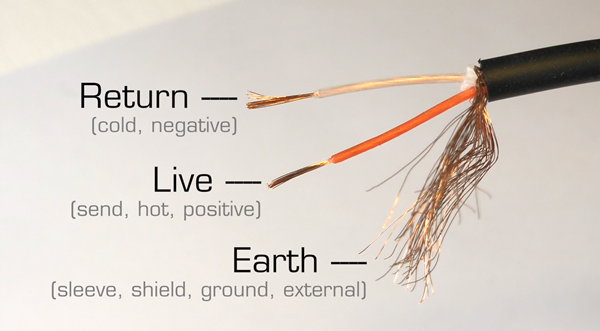Audio interconnection 14
Audio cables
- Video
- Script
Welcome to this tutorial on audio cables.
Most cables consist of an outer protective insulation layer, one or more inner cores, each with their own insulation, and a surrounding braided earth core shield. Between them, these cores carry the live, return, and earth signals. The cores can be of different thickness’s, or weights, and made from metals with a variety of electrical properties. The properties of these metals are expressed in terms such as resistance and capacitance and each are suitable for different types of leads.

Caption - Leads with the same connectors, but different cables
For example, despite using the same connectors, each lead in these pairs require a different type of cable ..
- Analogue phono to phono & SPDIF coaxial leads - each employing a different type of cable with a single inner core and surrounding earth shield
- Mic & AES3 leads - each employing a different type of cable with live and return inner cores and surrounding earth shield
- Guitar & head amp to cab leads - each employing a different type of cable with a single inner core and surrounding earth shield
Caption - Cable insulation
Each core in a cable must be electrically isolated to ensure they do not touch. If there is more than one core, each will be separated by its own individually identified insulation covering.
Many cables braid the earth core shield around the live and return cores. This helps it to protect the cores against external interference and drain it away to ground.
Caption - Wiring looms
A collection of cables gathered together, perhaps with cable ties, or in the form of a multi-core, is known as a wiring loom. Looms are often created to link a single multi-channel piece of equipment, or a rack of equipment, to another device or patchbay. An example would be to connect a stage box to a patchbay.
Caption - Cable length
Maximum cable length is usually limited to between a few meters and a few 10s of meters for analogue electrical, digital electrical, and optical signals, but this is not usually an issue in home and project studios. If audio is to be sent greater distances, other formats such as MADI and audio over IP are preferable.
Caption - Physical properties
When referring to cables it is usual to refer to their weight. A thin cable is often referred to as ‘light’ gauge and thick as ‘heavy’ gauge.
The weight of the metal in the cores does not always affect the quality of the signal passing along it. Providing the electrical properties are correct, decisions about weight are more likely to be informed by ergonomics. For example, because of space limitations, it is common to specify very light balanced installation cable for looms when wiring a patch bay to a mixing desk, but the same cable would not be used for making patch cords. A heavier gauge and more robust cable would be need to survive constant flexing, plugging and unplugging.
Caption - Typical cable gauges
Here are a some examples of typical cable gauges used for leads ..
- Balanced installation cable - light
- Mic cable - heavy durable, designed for constant flexing
- Unbalanced line level cable - medium
- Guitar cable - heavy durable, designed for constant flexing
- Speaker cable - heavy
- Multi-core - contains multiple light gauge balanced installation cables
- BNC word clock - heavy
- SPDIF coaxial - medium
- Optical - very thin and delicate
Sales literature about cables may also include details of the thickness of insulation layers, overall diameter, and number of strands in each core.
Caption - Electrical properties
The electrical properties of cables are expressed in terms of capacitance and resistance. For many applications it is essential that the correct type of cable is used. For example, speaker cab leads, SPDIF coaxial leads, and balanced installation leads all require very different types of cable.
However, it is no longer necessary for home and project studio owners to understand cable theory in-depth. When buying cable we can simply use a reputable specialist supplier who will identify the cables they sell in terms or their uses. So, for example, we can buy cable identified in a catalogue as being suitable for installation looms, mic leads, or AES leads, safe in the knowledge that they will be correct for the job in hand.
Caption - Coaxial cable
A coaxial cable is one in which a single insulated inner core is surrounded by a braided earth shield core. The term is often used in the context of a digital electrical signal connection such as an SPDIF coaxial lead, or BNC coaxial lead.
Caption - Thanks for watching
The script for this video, with accompanying images, can be found at projectstudiohandbook.com
We suggest you subscribe at our YouTube channel, and join our mailing list at our website to receive notification of new videos, blog posts and subscriber only extras.
Thanks for watching.